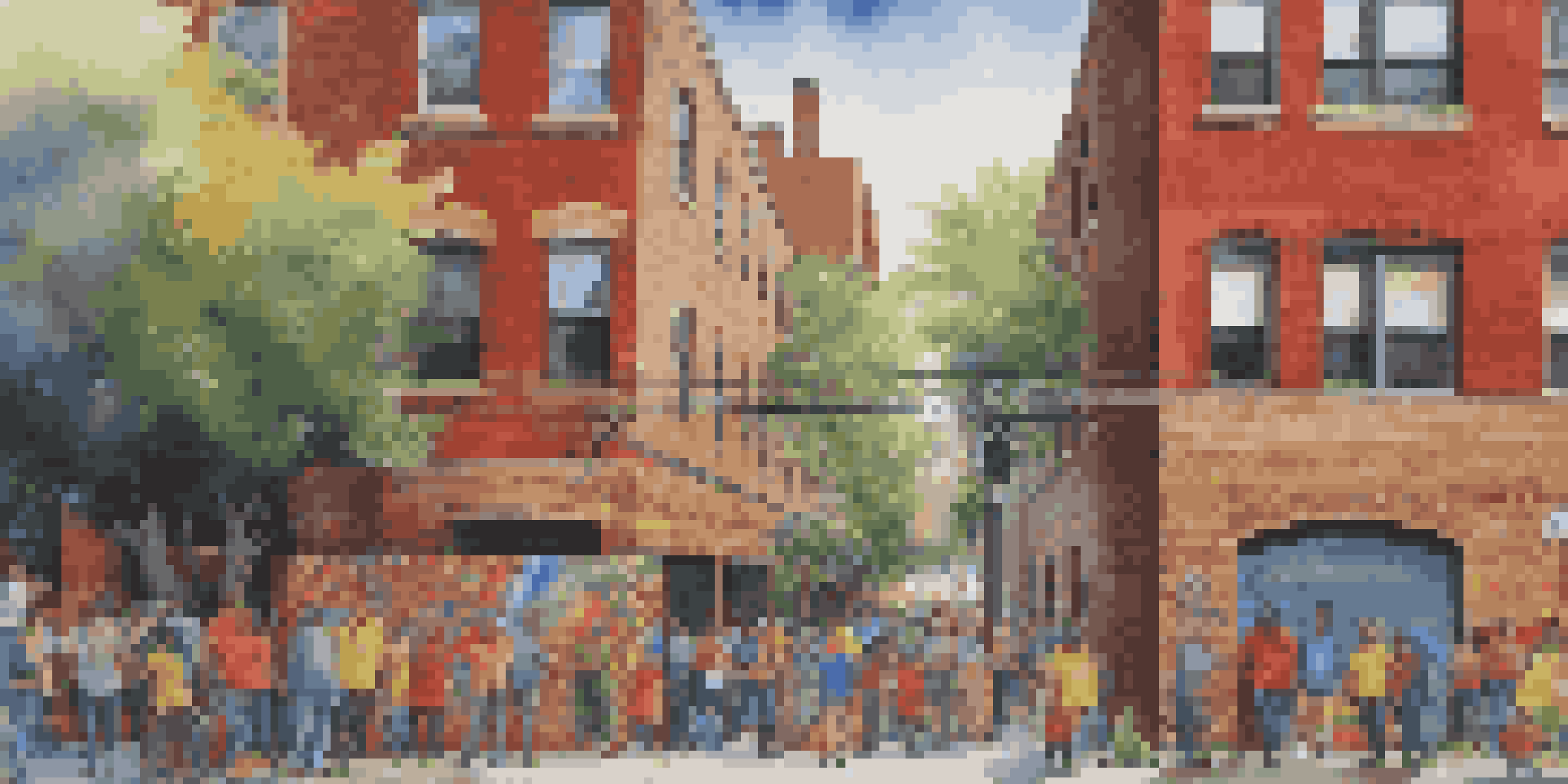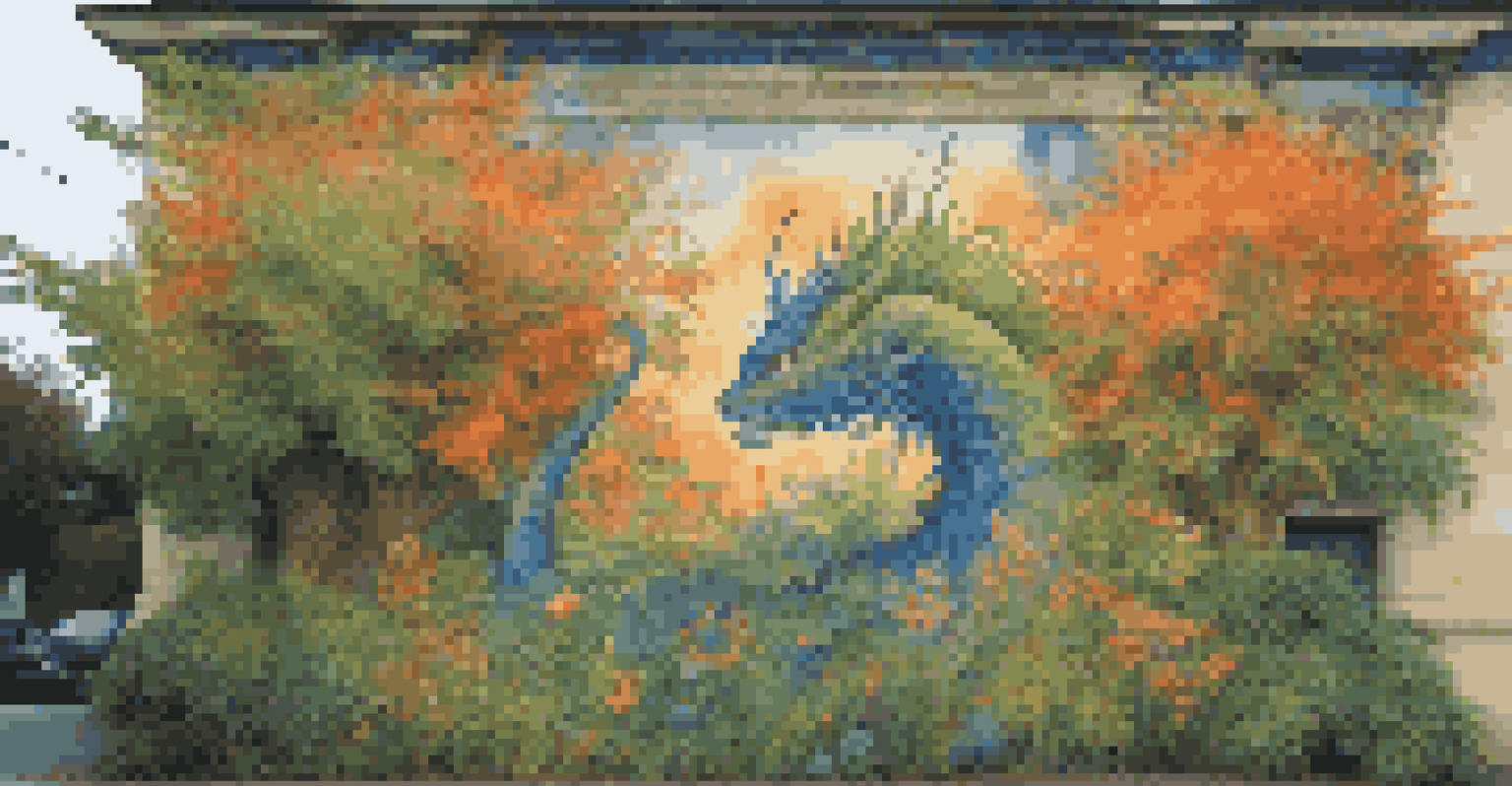The Aesthetics of Street Art: Beauty in Public Spaces

What is Street Art and Why Does It Matter?
Street art is more than just graffiti; it's a form of public expression that often conveys powerful messages. It includes a range of styles, from murals to stencils, and it transforms ordinary urban spaces into canvases of creativity. This art form captures the voice of the community, allowing artists to share their stories and perspectives in a vibrant, visible way.
Art is not freedom from discipline, but disciplined freedom.
In recent years, street art has gained recognition as a legitimate art form, celebrated in galleries and exhibitions worldwide. Its significance lies not only in its aesthetic appeal but also in its ability to challenge societal norms and provoke thought. By bringing art to the streets, it invites everyone, regardless of background, to engage with the work and its meanings.
Ultimately, street art matters because it democratizes art, making it accessible to all. It breaks down barriers that traditional art forms might impose, encouraging dialogue and interaction. When we stop to appreciate street art, we connect with our surroundings and the stories they tell.
The Role of Color and Form in Street Art
One of the most striking aspects of street art is its bold use of color. Artists often choose vibrant palettes to grab attention and evoke emotions. Colors can symbolize different things; for example, red might convey passion or anger, while blue can evoke calmness or sadness. This color theory plays a pivotal role in how viewers interpret the artwork.

Form is equally important in street art. The shapes and lines used can create movement and rhythm within a piece, drawing the viewer's eye in unique ways. Artists may employ geometric patterns or fluid, organic shapes to convey different messages, each contributing to the overall aesthetic experience. This interplay of color and form creates a dynamic visual language that resonates with passersby.
Street Art: A Voice for Communities
Street art serves as a powerful medium for public expression, reflecting the stories, struggles, and identities of local communities.
Moreover, the context of the piece—where it's located and its surroundings—adds another layer to its aesthetic appeal. A mural on a crumbling wall can tell a different story than one on a new building, showcasing the contrast between decay and renewal. Together, color and form not only beautify public spaces but also enhance the narrative of the urban landscape.
Street Art as a Reflection of Culture and Identity
Street art often emerges as a reflection of local culture and identity. Artists draw inspiration from their surroundings, incorporating elements that resonate with the community's history, struggles, and triumphs. For instance, a mural depicting local heroes or historical events can instill a sense of pride among residents and foster a connection to their heritage.
The role of the artist is to make the revolution irresistible.
Moreover, street art can serve as a platform for marginalized voices, allowing communities to express their unique identities and experiences. This is particularly significant in urban areas where diverse cultures intersect. By showcasing these stories through art, street artists contribute to a richer, more inclusive narrative of the city.
Ultimately, the aesthetics of street art become intertwined with the cultural fabric of the community. Each piece not only beautifies the space but also serves as a reminder of the values, challenges, and aspirations of the people who inhabit it. This connection between art and identity is what makes street art so powerful and meaningful.
The Impact of Street Art on Urban Environments
Street art has a transformative effect on urban environments, often breathing new life into neglected areas. When artists take to the streets, they can turn dull, lifeless walls into vibrant murals that attract attention and tourism. This revitalization can spark economic development by drawing visitors who come to see the art, benefiting local businesses.
Additionally, street art can foster a sense of community ownership. Residents may feel more connected to their neighborhoods when they see their stories and culture represented in public art. This sense of pride can lead to increased involvement in community initiatives, making citizens more invested in maintaining and improving their surroundings.
Color and Form Create Impact
The bold use of color and dynamic forms in street art enhances its ability to evoke emotions and convey messages to viewers.
However, the impact of street art isn't universally positive. While some view it as a form of beautification, others see it as vandalism. The ongoing debate about the legitimacy of street art highlights the need for dialogue about public spaces and how they should be used. Ultimately, the aesthetics of street art can stimulate important conversations about urban identity and community engagement.
The Evolution of Street Art Styles
Street art has evolved significantly over the decades, adapting to cultural shifts and technological advancements. From its roots in graffiti, which often focused on tags and simple designs, it has grown into a diverse range of styles that include stencils, wheatpasting, and large-scale murals. Each style brings its own aesthetic, engaging audiences in different ways.
The rise of social media has also played a crucial role in the evolution of street art. Artists can now share their work instantly with a global audience, allowing for greater collaboration and inspiration. This connectivity has led to the emergence of distinct movements, where artists influence one another across borders, creating a rich tapestry of styles and techniques.
Moreover, the incorporation of new materials and technology, such as spray paint, digital projections, and even augmented reality, has expanded the possibilities for street artists. These innovations not only enhance the aesthetic experience but also push the boundaries of what street art can be. This ongoing evolution ensures that street art remains a dynamic and relevant form of expression.
Controversies Surrounding Street Art
Despite its beauty and cultural significance, street art is often surrounded by controversy. Many cities have laws against graffiti, labeling it as vandalism, particularly when done without permission. This conflict between artists and local authorities raises questions about property rights and the value of public art, making it a contentious topic in urban development.
Moreover, as street art gains popularity, issues of commercialization arise. Some artists find their work co-opted for advertising or tourism, which can dilute the original message and intent behind the art. This commodification raises ethical questions about authenticity and the artist's voice within the public space.
Street Art's Complex Controversies
Despite its cultural significance, street art often faces controversy regarding its legitimacy, commercialization, and relationship with public space.
Ultimately, these controversies highlight the complex relationship between street art, society, and governance. They challenge us to consider how we define art and who gets to decide what belongs in public spaces. These discussions are crucial as we navigate the future of urban art and its place in our communities.
How to Appreciate Street Art in Your Community
Appreciating street art starts with simply being aware of your surroundings. Next time you're walking through your neighborhood, take a moment to look up and around; you might be surprised at the vibrant artworks that adorn the walls. Observe the details—the colors, the techniques, and the messages conveyed. Each piece has a story to tell.
Engaging with local art events, such as mural festivals or guided street art tours, can deepen your appreciation. These experiences provide context and insight into the artists' intentions, making the art more meaningful. You'll also have the opportunity to meet the artists, learn about their processes, and understand the cultural significance behind their work.

Finally, consider sharing your favorite pieces on social media or discussing them with friends. This not only spreads awareness but also fosters a community dialogue about the role of art in public spaces. By appreciating street art, you're not just enjoying its aesthetics; you're also participating in a larger conversation about culture, identity, and community.